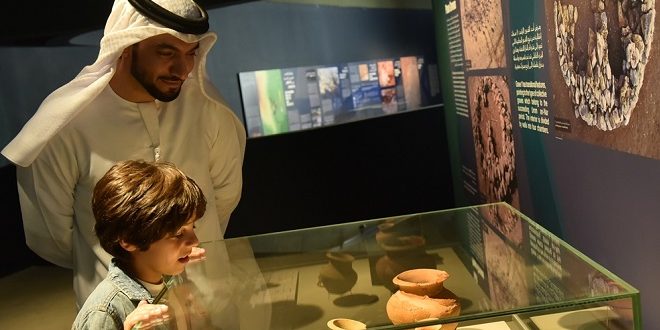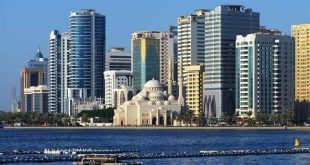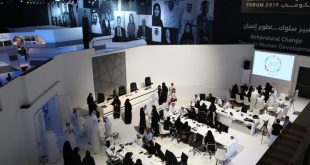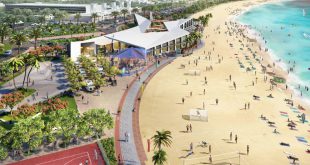Located in the central region of Sharjah, Mleiha is the truest epitome for the history of man in the GCC area, where which it became one of the world’s cradles for rich antiquity on human civilization and cultural legacy, dating 130,000 years ago. Mleiha Archaeological and Eco-tourism Project, developed by Sharjah Investment and Development Authority (Shurooq), was once home to the migration of Mankind from Africa, to the GCC region, Europe and Asia. For those who migrated to the GCC region, most found home in Mleiha where through its mountains they built caves, through its hills they built farms and through its meadows they built homes and palaces.
As time passed by, with the dynamic environment and climate change, Mleiha still managed to preserve these historic landmarks, with fossil rocks and mountains still bearing the testament of almost five key historic ages which passed through the area thousands of years ago.
The Mleiha Archaeological Centre is inspired by the area’s historical significance, architecturally conceptualized and built representing itself as the true gateway to one of the most ancient journeys of Sharjah. The symbolic structure of the centre reflects Mleiha’s natural landscapes which were resilient enough to preserve its history, enabling Shurooq to build the unique visitor centre in harmony and synchronization with those landscapes.
Mahmoud Rashid Deemas, Mleiha Archaeological and Eco-tourism Project Manager said: “The Mleiha Archaeological Centre is the first structure and the most iconic landmark since our development phase of the Mleiha Archaeological and Eco-tourism project. Through this visitor centre, we wanted to send an educational and inspirational message to all visitors even before walking into it, and that is our commitment to building unique structures that are a part of Mleiha’s remarkable nature and wonderful landscapes.”
The Mleiha Archaeological Centre serves as a uniquely designed visitor centre allowing visitors to explore and understand Mleiha’s history, as well as get close and personal with several archaeological discoveries which were excavated many years ago. The centre also has a restaurant where visitors can indulge in tasty meals along with a panoramic view of the fossil rocks and mountains of Mleiha.
The creativity behind conceptualizing the architectural linings, curves and shape of the centre paid homage to the Bronze Age, which is one of the five ages Mleiha went through since man first migrated there. The Umm Al Nar Tomb, which is found in the center of the construct and accessible to all visitors, served as a key historic monument which restored and preserved its momentous significance dating thousands of years ago. Moreover, the centre provides three unique experiences which surround the Tomb and those include the gentle descent of the Tomb, the promenade of the roof accessing an overview look of the Tomb and the exhibition area in the centre which itself tells the story of the Tomb as well as Mleiha.
Deemas added: “It’s just like how you read a book or a story. You go through different sequences until you fully understand and appreciate the story’s authenticity, and this is how we, at Shurooq, wanted to share the story of Mleiha to all visitors and tourists when we first conceptualised the visitor centre. We wanted to take them from the giant look of the Tomb onto the rich discoveries and findings which were made to understand what Mleiha really was. It didn’t take long for tourists and UAE residents to feel and realize the strong connection between the design of the Mlieha Archaeological Centre and the 130,000-year-old story it included, embarking on a true authentic experience on our Emarati traditions, values and history.”
Deemas highlighted: “Our innovation process was inspired by the tiniest details of the area’s history. These included the use of copper materials on the centre’s walls echoing the memories and evidences of when ancient copper workshops existed in the area thousands of years ago, the restoration of Palms and Ghaf trees in order to bring the environment conditions which the Umm Al Nar Tomb existed through when it was first built and the way the copper roof of the centre cascaded down in jagged forms mirroring the sharp edges of a desert rose. All these details allowed us to inventively look beyond from just building something on top of a piece of land, and allowed us to build something that was rather a part of a much bigger, larger and greater world.”
On Wednesday 7th September 2016, the Mleiha Archaeological and Eco-tourism project, developed by the Sharjah Investment and Development Authority (Shurooq), won the prestigious Cityscape Global – Best Community, Culture & Tourism Project Award in the Middle East. Attending the event and collecting the award were HE Marwan Bin Jassim Al Sarkal, CEO of the Sharjah Investment and Development Authority (Shurooq), along with top executives from the authority and the management team from the project.
Deemas explained: “It’s truly amazing to see how much we have achieved from this project since announcing its debut in January 2016. This award has successfully reflected our true commitment and dedication to promoting Sharjah in the most distinctive and innovative methods possible, and to genuinely position the Mleiha Archaeological Centre as one of MENA and the world’s award-winning culture and tourism centres for its authentic design and experience, thanks to the remarkable efforts of Dabbagh Architects.”
Deemas concluded: “I would like to finally congratulate all the other nominees who were competing against us in that same category. Those nominees included a remarkably designed by project from Hong Kong as well as another from South Africa. The high competition standards for this category has definitely made us realize the extent of all their efforts as well as ours which we have achieved behind developing projects out of passion and innovation.”
The Sharjah Investment and Development Authority (Shurooq) is responsible for the restoration, preservation and development of several tourism projects in Sharjah, in a bid to promote the emirate’s rich heritage, tradition and culture to all tourists and UAE residents. Its development process includes building features and construct which are in-line with the area’s environment, nature and landscape, as well as restoring several historical sites and buildings, integrating modern technologies and architectural designs and developing multiple facilities for visitors. This process is part of Shurooq’s dedication and vision to promote the most authentic and genuine form of cultural Emarati tourism in Sharjah and the UAE.
(Press Release)






